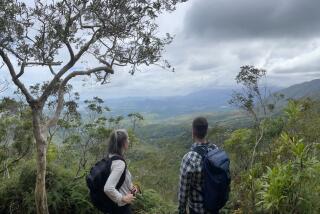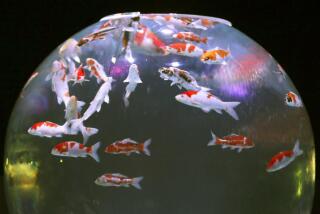Deadly Fish Provides Clues to Human Genes
- Share via
A deadly Japanese fish may be the next key to illuminating the mysteries of the human genome.
Scientists have reported decoding the genetic sequence of the Japanese pufferfish, Fugu rubripes, an expensive delicacy that contains potentially lethal poison in the organs. The fugu has about the same number of genes as a human, all stored in a DNA package an eighth the size.
The simplicity of the fugu’s genome offers scientists an unprecedented ability to identify new human genes. The two vertebrates share many of the same groupings of genes, even though they last shared a common ancestor almost half a billion years ago.
“The fugu is like the human genome with a 90% discount,” said Sidney Brenner, a professor at the Salk Institute in San Diego and one of the initiators of the fugu genome project.
Sam Aparicio, a professor in the oncology department at Cambridge University in Britain, who coordinated part of the project, called the fugu “the Rosetta stone of biology.”
“This is the first time we can compare on the scale of an entire genome a list of the protein parts of human and fish,” he said.
The fugu genome has approximately 365 million chemical base pairs, the letters that make up the genetic alphabet. That compares with the 3 billion letters that make up the human genome.
The small size of the fugu genome is one of the main reasons for its selection for sequencing. So far, only the genomes for the fugu, mouse and human are publicly available.
The project took only a year to complete through an international effort that included the Institute for Molecular Biology in Singapore and the U.S. Department of Energy’s Joint Genome Institute.
There are, of course, enormous differences between the fugu and human genomes. The complexity of the human genome makes finding genes like looking for a needle in a biological haystack.
While the sequence for the human genome was announced two years ago, scientists are still sifting through the complex string of genetic letters, looking for genes that direct the production of different proteins.
There are computer programs that predict which areas encode proteins, Aparicio said, but comparing gene sequences with another species gives more powerful evidence that something is a gene.
That’s where the fugu comes in.
Brenner said the fugu genome contains much less “junk DNA”--repetitive parts of the genetic sequence that exist between genes--than other vertebrates.
Because of the compactness of the fugu genome, the scientists were able to easily identify genes, which they then used to hunt for new human genes.
The group already has identified almost 1,000 new human genes, with the potential for a few thousand more, Aparicio said.
Researchers are also using the fugu genome to help them understand the parts of the human genome that regulate the activation of genes to produce proteins.
“Most of the differences between fish and ourselves is not the gene, it’s the way genes are used for development--where and when they are switched on,” Brenner said.
Researchers can take the regulatory portions of genes from the fugu and put them into mice. The genes function properly, giving scientists a clue to their purpose.
“When you cross mice and fish you can understand how genomes evolve and what makes complexities in organisms when the basic gene language is the same,” Brenner said.
John Ngai, a professor of neurobiology at UC Berkeley, who studies mice and zebrafish, said: “This is going to prove to be a great resource for the research community and will help us understand how vertebrate genomes are organized. It will help us in everything we do.”
The next organisms in the sequencing lineup include the chicken, chimpanzee, several species of fungi, a sea urchin, the honeybee and a microscopic protozoan called Tetrahymena.
Brenner, a pioneer in selecting animals for scientific study, doesn’t have a favorite up at bat. “Scientists should sequence pieces of the genomes of many organisms to utilize the continuity of nature to illuminate the most interesting organism: ourselves.”






